Terms and rules for planting celery for beginner summer residents
Gardeners are more willing to grow celery for greens. This is determined by the fact that agricultural technology is easier, and there are more vitamins and microelements in the leaves. But the petiole contains an increased amount of essential oils, and the root contains more fiber. Tubers are stored for a long time, retaining useful substances for several months and are used for forcing greens, and petioles are indispensable for diet food, soups and second courses.
The content of the article
Features of planting celery, depending on the type
The agricultural technology of this culture is not very different for all three types, but each has its own characteristics.
Root... Such celery It is grown in seedlings as it has a long growing season - on average 150-160 days. Therefore, seed preparation and sowing start already at the end of January - beginning of February, depending on the ripening time of a particular variety.
Stem / petiolate. This type of celery requires pre-sowing for seedlings in late February - March.
Sheet.The easiest way to plant is directly into the ground in late April - early May.
Important! If a grow only root celery, it will give both greens and tubers, but not petioles.
Landing dates
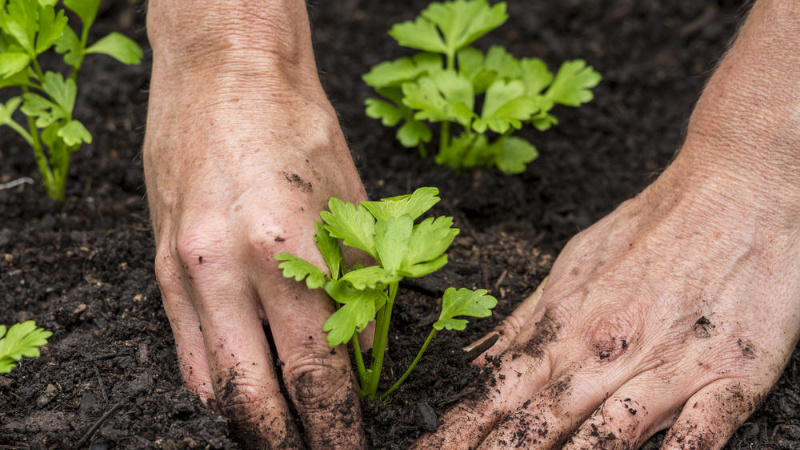
Depending on the type of celery chosen, planted:
- for seedlings: root in late January - early February, petiolate - in late February - early March;
- into the ground: root and petiole seedlings in late April - early May, leaf seeds - in early May.
Gardeners following the lunar calendar adhere to the rule: for root celery, planting falls on the waning moon, for petiolate and leafy - on the growing one.
When planting in the ground, they are guided by the weather - when a stable + 8 ° C is reached, celery can be assigned to a permanent place in the garden.
Auspicious days according to the lunar calendar
In 2020, the best dates for planting celery will be:
| Celery type | Month | Numbers |
| Root | January
February |
16-19
4, 13-16, 28, 29 |
| Stemlevoy | February
March |
6, 7, 24, 25
4, 5 |
| Sheet | April
May |
18
1-4, 6 |
Unfavorable days for all types of celery in 2020 will be: 21.01, 05.02, 06.03, 19.04, 05.05.
Important! Focusing on the lunar calendar, one should not forget about the prevailing weather conditions - even on the most favorable day, you should not land in open ground in the pouring rain or hail.
rules
To obtain juicy greens, delicate petioles and high-quality root crops, the seeding rates per unit area, crop rotation, and the proximity of crops are taken into account.
Crucifers, legumes, cucumbers and tomatoes are good precursors to celery. You can not grow it after carrots, parsley and dill because of the danger of infection with common diseases and pests. Planting celery in the same place for several years in a row is also not recommended.
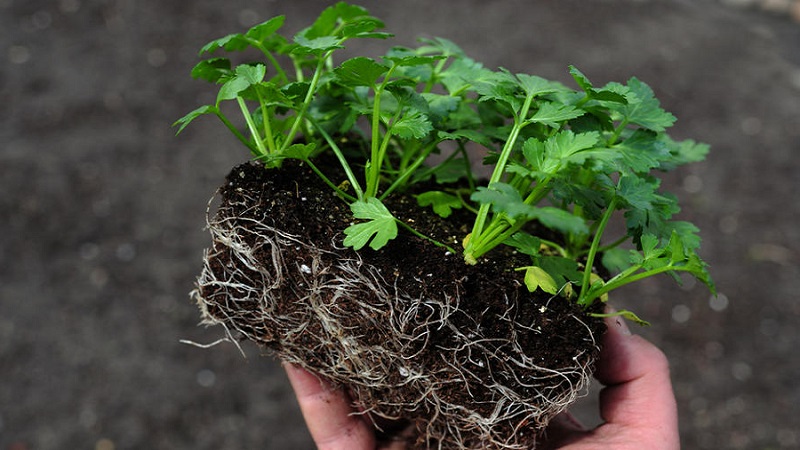
At what distance to plant
This culture requires a large food area. Therefore, the distance between plants in a row is maintained at 20-25 cm. Row spacing is 30-45 cm.
With this arrangement, all plants are well lit by the sun and do not suffer from a lack of nutrients and moisture in the soil.
What can / cannot be planted next to
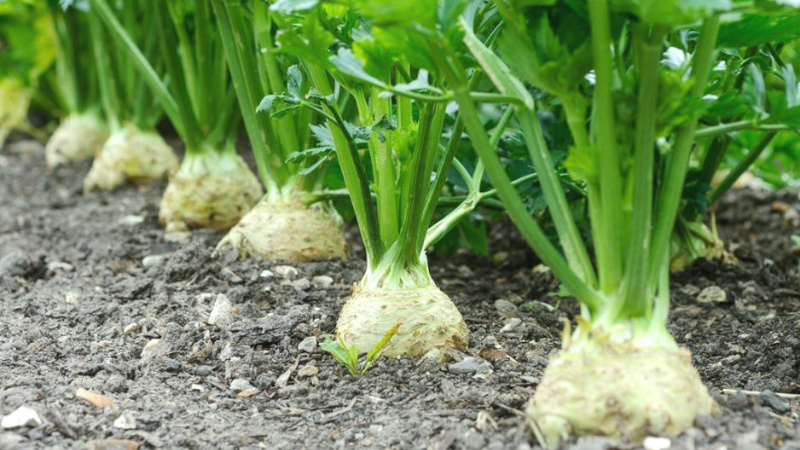
Celery does not tolerate the proximity of corn, potatoes, carrots and parsley.But it responds well to joint planting with white cabbage, beets, tomatoes, cucumbers, salad, beans.
Important! If you plant celery next to cabbage, it will drive away the white butterfly, and the cabbage stimulates the active growth of celery.
How to plant celery seeds
To obtain a viable, strong seedling, planting material is prepared in 5-6 days. This stage is important for disinfecting seeds and reducing the amount of essential oils in them, which will delay hatching for 20-30 days.
Preparation of planting material and soil
The substrate for sowing celery consists of peat (3 parts), soil (1 part) and compost (1 part). It is good to add 1/10 of the sand to the entire mass of the earth - celery loves loose soils. Lumps in the ground are not permissible, before planting it is thoroughly loosened and sifted if possible.
If the soil is taken from the garden, it is pickled with a hot, weak solution of potassium permanganate.
Important! Store-bought soil is already disinfected, so you can use it right away.
Celery seeds contain a large amount of essential oils that make germination difficult. Therefore, the planting material is kept for 3-5 days in warm water. Before soaking, the seeds are disinfected with a pale pink solution of potassium permanganate for 48 hours.
Planting instructions
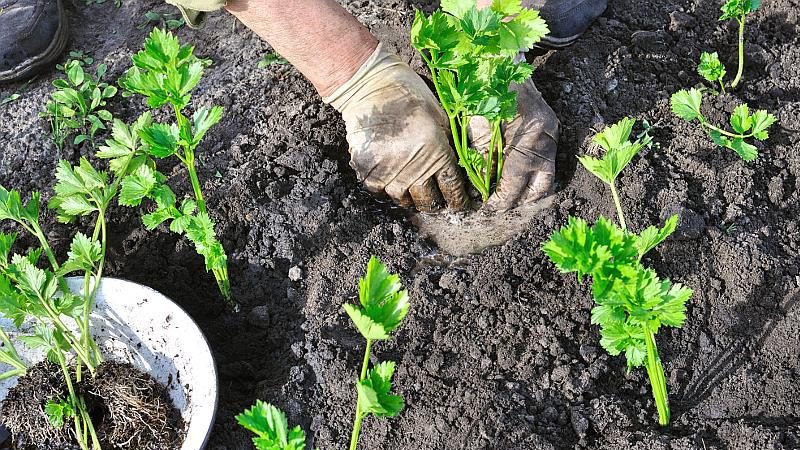
To improve germination, the following sequence of actions is observed:
- Celery seeds are small, so they are laid out on a damp cloth for germination in a warm place, covered with a film.
- After pecking, they are carefully placed on the soil surface and lightly sprinkled with sand.
- Moisten the topsoil with a sprayer.
- Boxes or beds with seeds are covered with glass or plastic, creating a greenhouse effect.
- After the appearance of the first leaves, the shelter is removed.
In the future, the seedlings dive into separate containers. The strongest seedlings are selected in the phase of 3-4 true leaves.
How to plant celery root
Tubers used for forcing leaves in the autumn-winter period. To do this, select strong, healthy roots and drop them 2/3 of the height into boxes with soil or into a greenhouse. After 25-30 days, the greens reach the grocery ripeness, they are cut off, and the roots are removed for storage.
Features of planting in open ground
As soon as the soil has warmed up enough, grooves are made in it at a distance of 30 cm from each other and a depth of 1-1.5 cm. Celery is rarely sown, otherwise there will be difficulties with thinning.
It is carried out in three stages: in the phase of 3-4 true leaves, they break through to a distance of 5-7 cm, after 2-3 weeks, 3-4 plants are left by 20 cm, after another two weeks they are reduced to one plant by 20-25 cm.
To the greenhouse
Planting celery indoors is carried out in the same way as growing seedlings. In a greenhouse or greenhouse, prepared and hatched seeds are laid out on the soil surface and sprinkled with a thin layer of sand. Additionally, they are covered with a film or non-woven material until the planting material germinates.
Other sowing methods
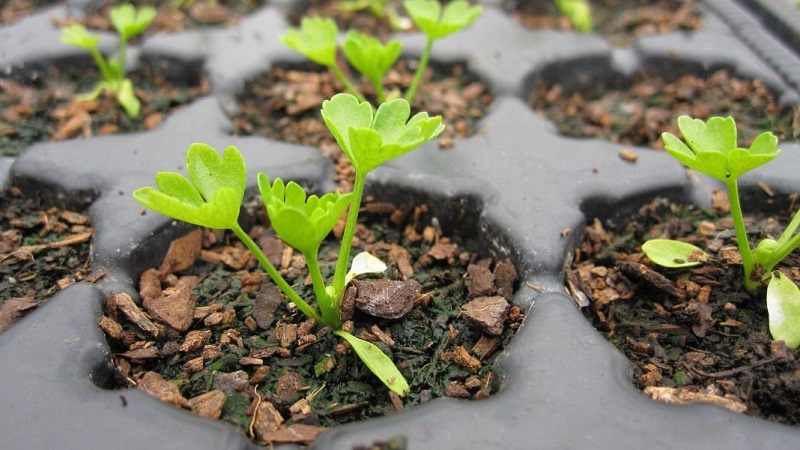
If you don't have a greenhouse or greenhouse, the only way to grow celery seedlings is at home on a windowsill. Suitable containers are boxes, plastic cups and peat tablets.
Into boxes with further pick
The prepared planting material is sown on the surface of the substrate, sprinkled with a layer of sand of 0.5-1 cm. Cover with glass or film, after moistening the soil from a spray bottle. After the seeds germinate, the shelter is removed, and the containers with the seedlings are left warm until two true leaves appear.
So that the plants do not stretch, but form strong, the air temperature should not exceed 15-16 ° C, such conditions can be easily created on a glazed loggia. For full development, seedlings need good lighting. In the absence of windows on the south side, celery is supplemented with a fluorescent or phytolamp.
The soil is moistened in a timely manner, avoiding drying out.
In the phase of 3-4 leaves, plants dive, seating them in separate containers - cassettes, cups, bags.
In peat tablets
Celery tolerates picking well, so it is grown in any container for seedlings. Peat tablets make the work of the gardener easier, while they are expensive and are used only once.
Attention. Before use, the tablets are soaked in warm water until they swell. Then sprouted celery seeds are placed in them one at a time and covered with foil until germination.
Care after landing
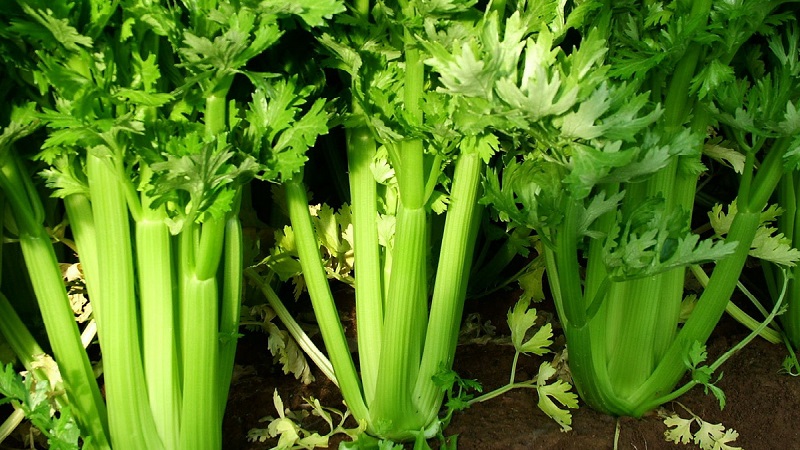
During the growing season, celery needs regular watering, loosening, 3-4 feeding and weeding. Additional care required root and stalked celery in the second half of the growing season.
Watering celery at the rate of 1-1.5 buckets of water per 1 m2.
Top dressing depending on the growing season:
- After planting, nitrogen fertilizers are applied to the soil.
- In mid-June - complex with a predominant nitrogen content.
- In July - a mineral complex with a low N concentration (the root can not be fed already).
- A month before harvesting, potash-phosphorus fertilizers are applied.
Important! With an excess of nitrogen in the soil, root celery forms small tubers with voids
Loosening the soil provides nutrition for the plant root system, the formation of a strong leaf rosette and tuber.
Petiolate celery in the second half of the growing season is highly spud or the stems are wrapped in thick paper. This is done to whiten - to obtain juicy, delicate, pale green petioles.
When forming tubers, root celery, on the other hand, is dug out until 1/3 of the fruit opens and the lateral roots are cut off. Otherwise, a root brush is formed instead of a root crop. Beginning in mid-August, the leaves are bent to the ground. Even if they break at the same time, nothing bad will happen. Root celery will continue to form the tuber.
Conclusion
Sowing of celery in most regions of the country is carried out through seedlings, since this culture has a long growing season. Seeds and soil are prepared in advance - even before tomatoes and eggplants. Care before planting in open ground consists in proper sowing, moderate moisture, timely picking and maintaining the desired temperature and illumination.